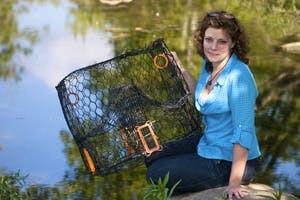by Heidi Ridgley
The sun was still shining when Alexandra Siess finished a hard day’s work retrieving nets used to catch and then count, measure, tag and release diamondback terrapins in the Chesapeake Bay. Siess, a biology field technician with the U.S. Geological Survey, was working on a project to gather data on the understudied and rapidly declining turtle population found in brackish waters along the Atlantic and Gulf coasts from Cape Cod to western Texas and the Florida Keys.

© Charles Kogod/Defenders of Wildlife
Instead of joining her fellow researchers on the private boat back to mainland Maryland as she usually did, she hopped aboard the evening ferry from Smith Island. It wasn’t long before she noticed some unexpected—and unwilling—passengers taking their own one-way ride. She was sitting next to six stacked boxes, each holding about 20 diamondback terrapins, their legs scrapping the sides or poking out through the slots.
It was a commercial fisherman’s catch for the day and it horrified Siess. “There we were spending all this time trying to find out how these turtles were faring while these were being shipped off to market the next day,” says Siess. “Were they animals we had tagged? It just struck me as extraordinarily awful. And it became crystal clear to me how pointless it was for us to be trying to conserve these animals if they were rapidly leaving the bay before we even knew if their population was stable or decreasing.”
This experience several years ago drove Siess to lobby Maryland legislators to enact a law to protect the state reptile in 2007. She worked with a variety of individuals and organizations including Defenders of Wildlife, which mounted an e-mail campaign in support of protection for turtles in Maryland. “I am so thankful for Defenders,” says Siess. “Though we had all the science in the world to show that a commercial terrapin fishery was unsustainable, that was not enough. The e-mail campaign showed lawmakers that both Defenders and the public were paying attention and cared about this species.”
Up until July 2007, commercial fishermen in the state could harvest an unlimited number of diamondback terrapins, a type of turtle that lives in brackish coastal waters, during a nine-month open season. Many of them ended up in food markets in China, according to a study by Conservation International. Others were found in the Chinatown markets of New York City and Albany, New York.
Because turtles are slow to reproduce—female diamondbacks do not lay eggs until they reach their early- to mid-teens—commercial fisheries can quickly decimate the species. “These turtles are homebodies—very territorial—so if you clear out most of the adults of a local population it’s unlikely the population will survive,” says Siess. “It can’t support a lot of adult losses.”
The loss of these small reptiles can have big consequences. The chief one is the population growth of saltmarsh periwinkles, the terrapins’ favorite food. “If the snails are left unchecked, they can totally denude the salt marsh grasses and their strong, sturdy root system,” says Siess. “Erosion goes haywire.”
Today, even with commercial fishing ceased, terrapins still face many threats. In the 16 eastern and southeastern states where they range, the two-pound turtles are still accidentally entangled in fishing nets. Boats hit them. Cars run over them as they try to get to nesting grounds. They are illegally poached, and their nests are raided by natural predators like raccoons. “Turtles never get a chance to get ahead,” says Siess. “They are losing 95 to 100 percent of the nests every year in some places. You can still see a few adults in these places but it is essentially a dead population.”
In the Chesapeake, the biggest problem now is fishing gear, including crab pots set by recreational users. Maryland—like some other states—requires “bycatch reduction devices,” which prevent turtles from entering, getting trapped and drowning, but not every crabber attaches them. And abandoned or derelict “ghost” crab pots lost in storms from both the commercial and recreational fisheries are also suspected of killing far too many turtles. “It’s amazing how many animals get caught in them and then drown at high tide,” says Siess. One errant crab pot can trap 100 terrapins. Looking at ways to clean them out of the bay is a task on the agenda of the Chesapeake Terrapin Alliance, a coalition group Siess cofounded while working to get the fishing ban passed.
“We first tackled the fishery because we knew it was unsustainable and it was the one known threat we knew we could stop,” says Siess. Next the alliance is working on regulations to prompt fishermen to check their gear more often to keep the turtles from drowning, to enforce state regulation for bycatch devices and to figure out how to get property owners involved in protecting nesting beaches.
“The lesson I learned from all of this,” says Siess, “is that anyone can make a difference. I didn’t know anything about legislative work. I found out it’s mostly just a lot of follow up, lots of on-the-ground work and lots of time and dedication. But mostly, all you have to do is care.”
Live in terrapin territory? Get some handy tips on how you can help terrapins survive.
Only select articles from Defenders are available online. To receive 4 issues annually of the full award-winning magazine, become a member of Defenders of Wildlife!
